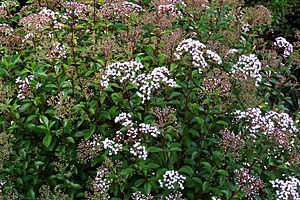Privet-leaved ageratina facts for kids
Quick facts for kids Privet-leaved ageratina |
|
|---|---|
 |
|
| Scientific classification | |
| Genus: |
Ageratina
|
| Species: |
ligustrina
|
| Synonyms | |
|
Synonymy
Eupatorium biceps Klotzsch ex Vatke
Eupatorium erythropappum B.L.Rob. Eupatorium ligustaefolium DC. Eupatorium ligustifolium DC. Eupatorium ligustrinum DC. Eupatorium micranthum Less. 1830 not Lag. 1816 Eupatorium myriadenium Schauer Eupatorium semialatum Benth. Eupatorium weinmannianum Regel & Körn. |
|
The Ageratina ligustrina, also known as the privet-leaved ageratina or privet-leaved snakeroot, is an evergreen flowering shrub. It belongs to the sunflower family. This plant is commonly found across much of Mexico and Central America, from Tamaulipas to Costa Rica.
This shrub can grow quite tall, reaching up to 4 metres (about 13 feet). In autumn, it produces flat clusters of white to pink flowers that look like daisies. These flower clusters can be as wide as 20 centimeters (about 8 inches) and have a lovely smell. They are known to attract butterflies. The leaves of the plant are light green and shaped like an oval or a spear, with small teeth along their edges.
Growing Ageratina ligustrina
People have been growing Ageratina ligustrina in gardens since the mid-1800s. In 1996, it received a special award called the Royal Horticultural Society's Award of Garden Merit. This award means it's a great plant for gardens.
However, this plant doesn't do well in very cold places. In the US, it grows best outdoors in warmer areas, specifically in hardiness zones 9–11.
Common Plant Pests
When grown outdoors, A. ligustrina can sometimes get bothered by small creatures like slugs and aphids. If the plant is grown in a greenhouse, it might attract whiteflies and tiny red spider mites.
What's in a Name?
The name Ageratina comes from the Greek word meaning 'un-aging'. This refers to how the plant's flowers keep their color for a long time. An ancient Greek doctor named Dioscorides used this name for several different plants.
The second part of the plant's scientific name, ligustrina, is a Latin word. It points out that the plant looks similar to the privet plant, which is called Ligustrum. Even though they look alike, these two plants are not closely related.
See also
 In Spanish: Ageratina ligustrina para niños
In Spanish: Ageratina ligustrina para niños

